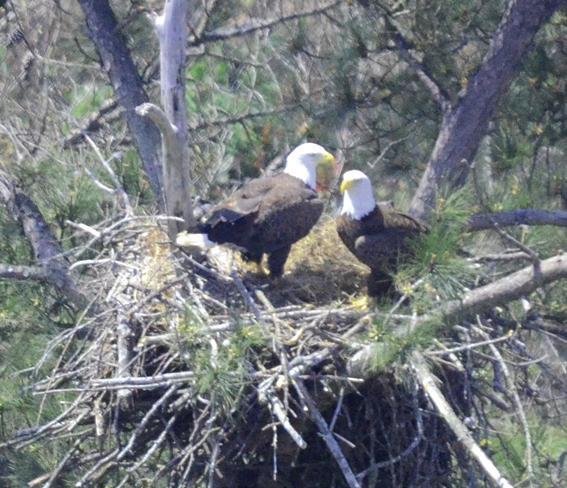
4 minute read
American Icon: Bald Eagles
Georgia Nesting Update
By Rick Lavender Communications and Outreach Specialist GADNR Wildlife Resources Division
Advertisement
An adult bald eagle resting on a convenient perch. Photo by Tim Keyes, GADNR
The bald eagle is holding its own in Georgia.
Six coastal counties were surveyed by helicopter in the winter and spring and another 12 nests were monitored on foot. The coastal counties reported nesting totals almost identical to 2020 and in line with annual averages. Those 71 occupied nest territories fledged 81 young, and 55 nests fledged at least one eaglet. Survey leader Dr. Bob Sargent said six new occupied nest territories were found on the coast, plus three elsewhere in the state.
All told, the 83 territories monitored this year fledged 94 young, or 1.5 young per nest, which is the long-term average in Georgia.
What isn’t average: Sargent is seeing more eagles nesting closer to areas where there’s more human activity. As a rule of thumb, most eagle pairs in Georgia avoid nesting near man-made structures and human-associated disturbances.
While there have been exceptions, Sargent said 2021 featured increased reports of eagles nesting "or exhibiting behaviors associated with the establishment of nesting territories on small lakes in the midst of extensive development.” This was especially the case on the north edge of metro Atlanta and the margins around Savannah.
Have bald eagle numbers soared to the point that the best territories are taken, and birds are nesting in areas they once shunned?
The U.S. Fish and Wildlife Service estimates there are 316,000 bald eagles in the lower 48 states, a fourfold increase since 2009. Georgia nest totals grew from about 100 in 2007 to 200-plus in 2015.
Florida, home to more than 1,500 territories, is documenting eagles nesting in unexpected places, including near urban areas and on electrical towers and other man-made structures.
“Perhaps more eagles, especially those classified as floaters because they sort of hang out waiting for territories to become available, are discarding the rule and building homes closer to us,” Sargent said.

Photo provided by GADNR

• Six coastal counties: 71 occupied nest territories, with 55 nests fledging at least one eaglet (78 percent success rate, which is average), 81 young fledged (1.5 per successful nest – average) and 1.1 young fledged per occupied nest territory (average). Six new occupied nest territories found.
• Monitored on foot: 12 occupied nest territories, with nine fledging at least one eaglet (75 percent success rate), 13 young fledged (1.4 per successful nest) and 1.1 young fledged per occupied territory. All of these stats are average for the state. Three new occupied territories found.
• Totals: 83 occupied nest territories, with 64 fledging at least one eaglet (77 percent success rate), 94 young fledged (1.1 per occupied territory) and 1.5 young fledged per successful nest. Again, these stats are average.

This bald eagle photo was taken at the Altamaha Wildlife Management Area. Photo by Clay George, GADNR
NEST SURVEYS
Largely because of the eagles’ sustained recovery, in 2018 DNR switched from flying the entire state each year to checking coastal counties annually – they have the most nests and potential development impact issues – and alternating between checking nests in the Piedmont and mountain ecoregions in even years, and the rest of the Coastal Plain in odd years. The change maintains standardized monitoring, syncs with the raptor’s range-wide comeback and mirrors slimmed-down eagle surveys in some neighboring states. It also frees money for other conservation projects.
Photo provided by U.S. Fish and Wildlife Service

About Bald Eagles • The bald eagle’s scientific name, Haliaeetus leucocephalus, means sea (hali), eagle (aeetos), white (leukos), and head (cephalos) as in the feathers on the eagle’s head. The word “bald” comes from the old English “balde,” meaning white. • Unique to North America, these birds are among the largest on the continent. The Bald Eagle's wingspan is slightly greater than a great blue heron, measuring an average of 80.3 inches. They range in height from 27.9 to 37.8 inches and can weigh up to 222 ounces (13.88 pounds). • Although they prefer fish, they are opportunistic feeders and will prey on other birds and mammals, steal food from other birds, such as osprey, or even eat carrion.
• Bald eagles begin breeding at the age of four or five and may mate for life. In our coastal region they nest in trees, usually choosing trees taller than the surrounding forest. They frequently reuse their nests year after year, adding on material with each nesting season.
• Males and females both build the nests and tend to their young. Fledglings typically begin flying at 10 - 12 weeks.
• In Georgia, the species is listed as threatened and protected under Georgia's Endangered Wildlife Act, and also at the federal level under the Bald and Golden Eagle Protection Act (as noted) and the Migratory Bird Treaty ActViolation of this act is punishable with fines and imprisonment.
To Learn More About Bald Eagles



Photo provided by GADNR
Photo provided by GADNR










